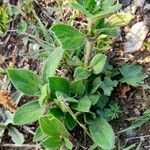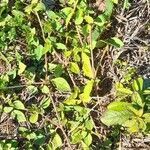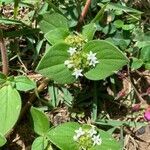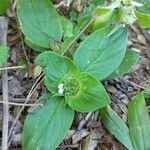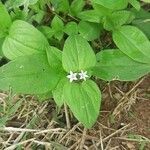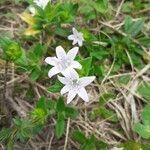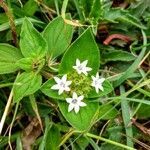Herbs, annual, decumbent or suberect, to 80 cm or longer; stems flattened to subterete, hispidulous or scaberulous and hirsute. Petiole 5-10 mm, hispidulous to pilosulous; leaf blade drying membranous to thickly papery, ovate, elliptic, or lanceolate, 1-5 × 0.5-3.5 cm, both surfaces scaberulous to glabrescent, base acute to cuneate, apex acute to obtuse; stipule sheaths 1-3 mm, pilose to pilosulous, with 3-11 setae 2-4 mm. Inflorescences ca. 1 cm in diam. (not including leaflike bracts or subtending leaves). Calyx with ovary portion obovoid, 1-1.5 mm, densely papillose or hispidulous to smooth; lobes 6, lanceolate or narrowly lanceolate, 1.5-3.5 mm, glabrescent, margins ciliate, apex acute. Corolla white, glabrous inside and outside; tube 3-8 mm; lobes 6, 1-3 mm. Fruit with mericarps 3, ellipsoid to obovoid, laterally somewhat dorsiventrally flattened, 2-3 mm, dorsally papillose to subsmooth, ventrally with 2 broad parallel grooves along length of face. Fl. and fr. Feb-Sep.
Perennial, prostrate herb, stems ± 0.2 m long; taproot central, mat-forming, densely hirsute. Leaves: blades elliptic, base narrowly attenuate, apex acute; petioles up to 15 mm long; upper surface, margins and nerves beneath shortly hairy. Stipular sheath up to 3.5 mm long, with 3-5 fimbriae. Inflorescences up to 12 mm in diam.; bracts ovate-oblong, rounded at base. Calyx: tube up to 1.7 mm long; lobes 5 or 6, ovate-triangular. Corolla white tinged pink, up to 3.2 mm long; lobes 4-6. Style up to 4 mm long. Flowering time Jan., Feb. Fruit brown, oblong-obovoid cocci, inner face with smooth depressed area.
Annual or perennial herb. Stems procumbent. Leaves with blade elliptic, base narrowly cuneate, apex acute, upper surface hairy; stipular sheath 1.0-3.5 mm long, with 3-5 fimbriae 1-4 mm long, usually with long hairs. Flowers: (5)6-merous; style with 2 arms; corolla white, often tinged pink; Sep.-Jun. Fruit oblong-obovoid mericarps with depressed area of inner face almost as broad as face, outer surface papillose and ± strigose.
Leaf blades 1–6.5 x 0.4–2.7 cm., elliptic, acute or subacute at the apex, very narrowly attenuated to the base, the apparent petiole up to 1.5 cm. long, mostly with short hairs all over the upper surface and on the margins and nerves beneath; basal narrowed part with longer hairs; stipular sheath 1–3.5 mm. long, with 3–5 fimbriae, 1–4 mm. long, usually with long hairs.
Inflorescences 0.7–1.2 cm. in diam.; bracts ovate-elliptic, rounded at the base, the long ones 1.5–3.5 x 0.65–2 cm., the short ones 1–1.7 cm. x 4–9.5 mm., or sometimes lacking, with a similar indumentum to that on the leaves, save that there are much longer hairs towards the base; basal part of bracts often subhyaline.
Much like no. 1 [Richardia scabra L.], but becoming perennial, and more hairy, the lvs appressed-hispid on both sides; fr 2.5–3(–4) mm, its obovoid cocci with broad, open, medially keeled adaxial scar; 2n=28, 84. Disturbed, often sandy sites; native to tropical Amer., and extending ne. to se. Va. as a weed.
Cocci brown, 2–2.6 x 1.4–1.6 mm., oblong-obovoid, inner face with smooth depressed area (i.e. actual septum of ovary) almost as broad as the face, dorsal face covered with short flat hairs which are longer in the middle or a mixture of papilla-like hairs and longer hairs.
Calyx tube 1.2–1.7 mm. long; lobes 5–6, 1–1.5 x 0.3–1 mm., ovate-triangular, the margins conspicuously ciliate, basal united part of the limb 0.5–1 mm. long.
Perennial (or ? annual) prostrate herb, often forming a mat, from a central taproot; stems 7–40 cm. long, densely covered with spreading hairs.
Seeds brown, 2.5 x 1.8 mm., compressed oblong-obovoid, with ventral face Broadly grooved, with 2 short basal projections 0.1 mm. long.
Style 3–4 mm. long, the branches 0.2–0.5 mm. long; stigmas 0.2–0.3 mm. long, spathulate.
Corolla white often tinged pink, 2.7–3.2 mm. long; lobes 4–6, 1–1.4 x 0.5–0.8 mm.
A hairy, branched prostrate herb with stems up to a foot long
Introduced weed.
Flowers white
